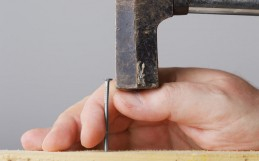Foot pain is one of the most common conditions I see in my practice. From a structural perspective, this makes a lot of sense, as our feet form the foundation for our skeletal framework, just like a solid foundation forms the basis for a house.
Common Foot Problems
There are so many problems associated with poor foot mechanics, such as mechanical lower back pain, knee pain, and hip pain. There are even more conditions directly related to the foot itself, like bunions, hammer toes, fallen arches, heel spurs. However, in this blog, I will focus on one of the most common conditions called plantar fasciitis. The name sounds scary, but translated it just means “inflammation of the plantar fascia” — the thick connective tissues that originate in the heel and stretch to the ball of the foot.
The most common sign of plantar fasciitis usually occurs when we get out of bed. If you have inflamed plantar fascia, the first step you place on the floor is likely to be very painful.
Why does this happen? It’s because, when we place direct weight on our foot, the fascia get “stretched” to the point where tiny microscopic tears occur within the connective tissue. These are called “micro-traumas”. Think of them as similar to when you tug on a loose thread on your sweater. The more you pull on the thread, the more likely it will unravel and unwind until the fascia literally pulls away from the bone itself…ouch!
Causes of Plantar Fasciitis
How did this occur in the first place? There are many possible causes of plantar fasciitis, but a couple of the most common mechanisms of injury to the plantar arch are either: (a) standing on hard surfaces in poor shoes, or (b) repetitive strain injuries from running. I always say to my patients that if you are going to splurge on yourself, make sure you spend it on a pair of good shoes with proper support and function.
Plantar Fasciitis Treatment
How do we treat it? The first thing I examine are your feet and how they function in relation to the rest of your body. If your arches are flat and have “fallen”, then I may recommend a custom set of orthotics to help support your specific foot contours. This will alleviate the mechanical stress and strain on your plantar fascia so it can heal properly.
Pulsed Radial Shockwave Therapy
Pulsed Radial Shockwave Therapy is a very effective modality for treating patients who suffer from debilitating plantar fasciitis. I can confidently say that we see a 95% plus success rate in our clinic when shockwave is properly applied to the treatment of plantar fasciitis. Used in conjunction with gentle stretches, regular soaking of the foot in an Epsom salt bath and icing (here’s a tip — roll your foot on a bottle of frozen water for about 5-10 min), I found that recovery and return to functional mobility is much quicker. One case took only 2 treatments to resolve his painful case of plantar fasciitis completely!
Proper Footwear
It is vital that you provide your feet with proper footwear during the course of treatment, and afterwards, to prevent the condition from returning. Have your foot assessed by a qualified healthcare practitioner, who can pinpoint areas of biomechanical weakness in your foundational support and make appropriate recommendations. After all, a house can only stand on a firm foundation. Trust me, your feet and body will thank you for it and then some!
To get treatment for plantar fasciitis, contact the team at Dr. Lee Health & Wellness in Ontario.





